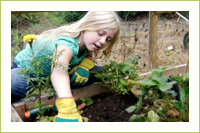
So what exactly is an educational school garden?
Basically, it is an outdoor classroom that is set in a working garden. It is a place where children can learn about science, math, ecology, language arts and even social studies. It can inspire writer’s workshops, art projects, nutrition awareness and increase hands-on science exploration. An educational garden can be a curriculum integrator – eventually touching all topics of study.
An educational garden is a living laboratory where lessons are drawn from real-life experiences rather than textbook examples. A garden can teach children responsibility, cooperation, and a new appreciation for nature and ecology. They learn about environmental responsibility while cultivating their imagination. Many times, an educational garden will create lifelong gardeners, environmentalists and healthy eaters.
Gardens like this are sprouting up are all over the country. Many are trying to follow the success of the Edible Schoolyard in Berkeley, California, a one-acre organic garden at the Martin Luther King Junior Middle School. That garden was started 13 years ago by restaurateur, Alice Waters. Before the garden was implemented, the students there did not fully understand where their food came from. Now they not only understand the growing process, they also eat the vegetables they grow. The Edible Schoolyard has become the model for other schools to follow.
Educational gardens are also a response to the fact that today’s kids lack an exposure to nature. Children spend more time playing with electronic media (TV, video games, etc.) than they do enjoying the great outdoors and this lack of outside activity is taking its toll. Obesity and developmental problems are growing rapidly among America’s children. Many studies have shown that contact with nature helps ease attention-deficit disorder, aids cognitive development, enhances creativity and reduces stress. The term “Nature Deficit Disorder” (coined by author, Richard Louv) is commonly used to describe the developmental problems cause by the lack of time outdoors. A school garden can be the springboard to get children and their families more connected to the outside world and reduce this condition.
But there is another reason that some schools are trying to get students outside. Due to budget cuts, many schools across the country havehad to sacrifice some subjects (art, music, environmental education, social studies and science) in order to focus more on the subjects found on the high-stakes tests (reading and math). Even field trips and outdoor activities have been reduced at some schools. These budget cuts have caused some administrators to look at integrating outdoor learning with a garden into core subjects. It is a less expensive program that still offers an alternative to straight book learning.
An educational garden really does create a magical learning experience for students. Once the concept and volunteers are in place, all that is needed to go with all that enthusiasm is a little sunshine and a packet of seeds.
Editor's Note: The deadline for the 2011 "I Can Grow" Youth Garden Award application is approaching! Download the application here.